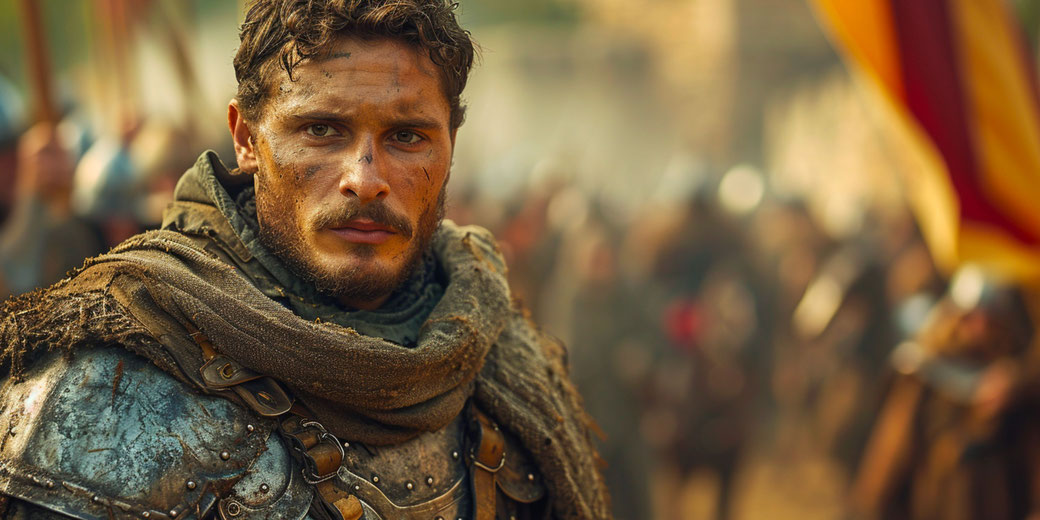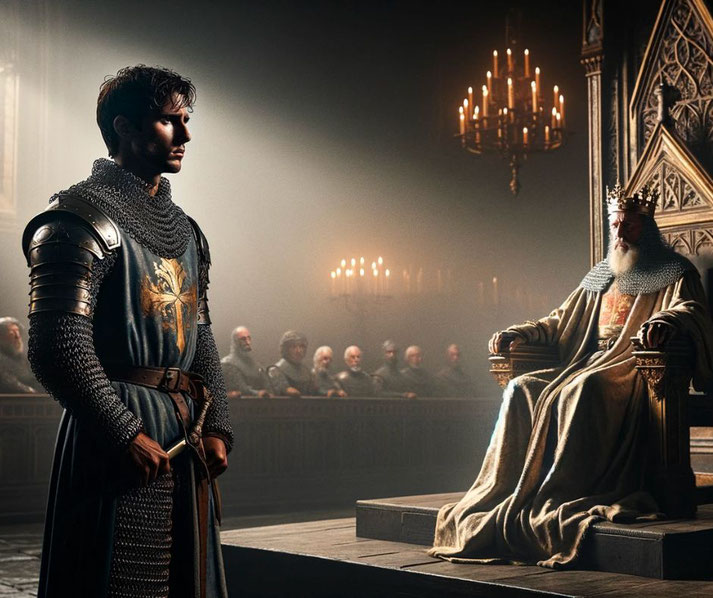Lancelot: The quintessential medieval knight who destroyed a kingdom for love

In the Arthurian legends, the character of Sir Lancelot is perhaps one of the most complex and enduring figures in medieval literature.
He first appeared in the early 12th century, emerging as a prominent figure in the works of Chrétien de Troyes, a French poet who played a pivotal role in shaping the Arthurian world.
Lancelot's character, often associated with chivalry, bravery, and tragic romance, profoundly influenced the portrayal of knights and heroes in subsequent literature.
But who was this legendary knight?
What truths lie behind his enduring romance with Queen Guinevere?
And how did this love shape the destiny of Camelot?
Historical development of Lancelot
Lancelot's first notable appearance in the works of Chrétien de Troyes, a 12th-century French poet.
Chrétien's romance "Lancelot, the Knight of the Cart," written around 1177, is credited with introducing Lancelot as a leading figure in the Arthurian world.
This work marked a significant departure from earlier Arthurian tales, which did not feature Lancelot, by placing this newly conceived character at the center of the narrative, particularly highlighting his affair with Queen Guinevere.
Following Chrétien's portrayal, Lancelot's character rapidly grew in popularity and complexity, becoming a fixture in subsequent Arthurian tales.
The 13th-century Vulgate Cycle, a series of French prose romances, further elaborated on Lancelot's story.
In these texts, Lancelot's backstory as the son of King Ban of Benwick and his upbringing by the Lady of the Lake are detailed, expanding his character beyond a mere knightly figure to a protagonist with a rich personal history.
The evolution of Lancelot's character continued through various medieval works, including the Post-Vulgate Cycle in the later 13th century.
Here, the focus shifted more towards his spiritual struggles and his quest for the Holy Grail.
This period saw a transformation in Lancelot's portrayal from a primarily secular hero to a more complex character struggling with sin and redemption, reflecting broader shifts in medieval religious and cultural values.
Lancelot's story and character continued to be adapted in later centuries. Sir Thomas Malory's "Le Morte d'Arthur," completed in 1470, became one of the most influential English-language versions of the Arthurian legend.
Malory's compilation and interpretation of the French romances cemented Lancelot's place in the English-speaking world, blending the knight's martial prowess, romantic endeavors, and spiritual quests into a single narrative.

Why he was considered to be the 'ideal knight'
His narrative arc, spanning various medieval texts, presents him as both the epitome of knightly virtues and a figure deeply flawed by personal weaknesses.
On one hand, Lancelot is celebrated for his unmatched bravery, skilled combat, and steadfast loyalty, particularly to King Arthur.
These qualities make him the archetypal medieval knight, embodying the ideals of chivalry that were revered in the period.
As one of Arthur's most trusted knights and a central member of the Round Table, Lancelot's loyalty and service to Arthur are unquestionable on the battlefield.
He is often portrayed as Arthur's greatest champion, fighting valiantly for the king's causes.
Lancelot's various encounters with other knights and creatures during his quests also contribute to his legend.
These encounters often involve battles or challenges that test not just his physical strength and skill, but also his moral and ethical judgment.
For instance, his duel with Sir Tarquin, a notorious knight who imprisoned fellow knights, showcases Lancelot's role as a rescuer and a champion of justice.
His tragic love affair with Queen Guinevere
The love triangle involving Lancelot, Queen Guinevere, and King Arthur is one of the most emotionally charged and pivotal elements of the Arthurian legends.
Lancelot, celebrated as the greatest of Arthur's knights, finds himself in a forbidden romance with Guinevere, Arthur's queen.
This relationship, both deeply passionate and fraught with danger, forms the crux of numerous Arthurian narratives, underscoring the human capacity for both great love and profound betrayal.
At the heart of this love triangle is the conflict between duty and desire. Lancelot's love for Guinevere challenges his loyalty to Arthur, creating a tension that resonates throughout the Arthurian tales.
His affair with the queen is a direct violation of the codes of chivalry and loyalty that he, as a knight of the Round Table, is sworn to uphold.
The romance, therefore, not only jeopardizes his status as a paragon of knighthood but also threatens the very stability of Arthur's kingdom.
For Guinevere, the relationship with Lancelot presents its own set of complexities. As the queen, her affair endangers her position and the peace of the realm.
Her character is often portrayed as torn between her duty to her husband, Arthur, and her love for Lancelot.
This inner turmoil adds depth to her character, making her more than just a passive figure in the narrative.
King Arthur's role in this triangle is both poignant and tragic. Often depicted as a noble and just ruler, Arthur's dilemma over the affair challenges his kingly virtues of justice and magnanimity.
The revelation of Lancelot and Guinevere's affair is a source of deep personal pain and betrayal for Arthur, yet he is often shown to be conflicted, torn between his love for his wife and his closest friend, and the need to uphold justice and the law.

The quest for the Holy Grail
Another significant aspect of Lancelot's adventures is his participation in the quest for the Holy Grail.
This quest represents a spiritual journey, a stark contrast to his earthly endeavors and romantic escapades.
Despite being one of the most capable knights, Lancelot's personal failings, particularly his affair with Guinevere, prevent him from achieving this ultimate Christian relic.
His failure in the Grail quest underscores the theme of human fallibility and the idea that even the greatest heroes have their flaws.
As one of the greatest knights of the Round Table, Lancelot's actions and decisions are often illustrative of the chivalric code, which emphasized bravery, honor, and service.
However, his character also highlights the limitations and conflicts inherent in this code, especially when personal desires come into conflict with societal expectations and duties.
His spiritual journey, particularly evident in the quest for the Holy Grail, is marked by a profound sense of personal inadequacy and guilt, primarily stemming from his affair with Guinevere.
This quest represents a struggle for spiritual purification and redemption, reflecting the medieval fascination with the ideas of sin, penance, and salvation.
Lancelot's failure to achieve the Grail, often attributed to his moral failings, adds a tragic dimension to his character, emphasizing the theme of human fallibility.

What role did Lancelot play in the fall of Camelot?
The affair between Lancelot and Guinevere undermines the moral and societal foundations of Camelot, a realm built upon ideals of chivalry, honor, and justice.
As one of King Arthur's most trusted knights and the queen's consort, their betrayal is not just a personal failing but a breach of the code of conduct expected at the Round Table.
This transgression serves as a catalyst for a series of events that lead to internal strife and discord among the knights, eroding the unity and strength that Camelot was known for.
The revelation of their affair causes a deep rift within the Round Table. Knights who were once brothers-in-arms are now divided, some supporting Lancelot, while others, like Sir Gawain, feel a deep sense of betrayal and demand justice.
The ensuing conflict results in a civil war, pitting knight against knight, which weakens the kingdom and makes it vulnerable to external threats.
Moreover, Lancelot's actions indirectly contribute to the weakening of Arthur himself.
The betrayal by his wife and his most esteemed knight not only breaks Arthur's heart but also diminishes his authority and moral standing as king.
The personal anguish and political turmoil that Arthur faces in the wake of Lancelot and Guinevere's affair distract him from the governance of his realm, further destabilizing Camelot.
Despite his noble qualities and heroic deeds, his affair with Guinevere sets into motion a chain of events that lead to the unraveling of the Arthurian world.
His story serves as a reminder of the fragility of ideals and the profound impact personal choices can have on a larger community.
What do you need help with?
Download ready-to-use digital learning resources
Copyright © History Skills 2014-2025.
Contact via email
With the exception of links to external sites, some historical sources and extracts from specific publications, all content on this website is copyrighted by History Skills. This content may not be copied, republished or redistributed without written permission from the website creator. Please use the Contact page to obtain relevant permission.





